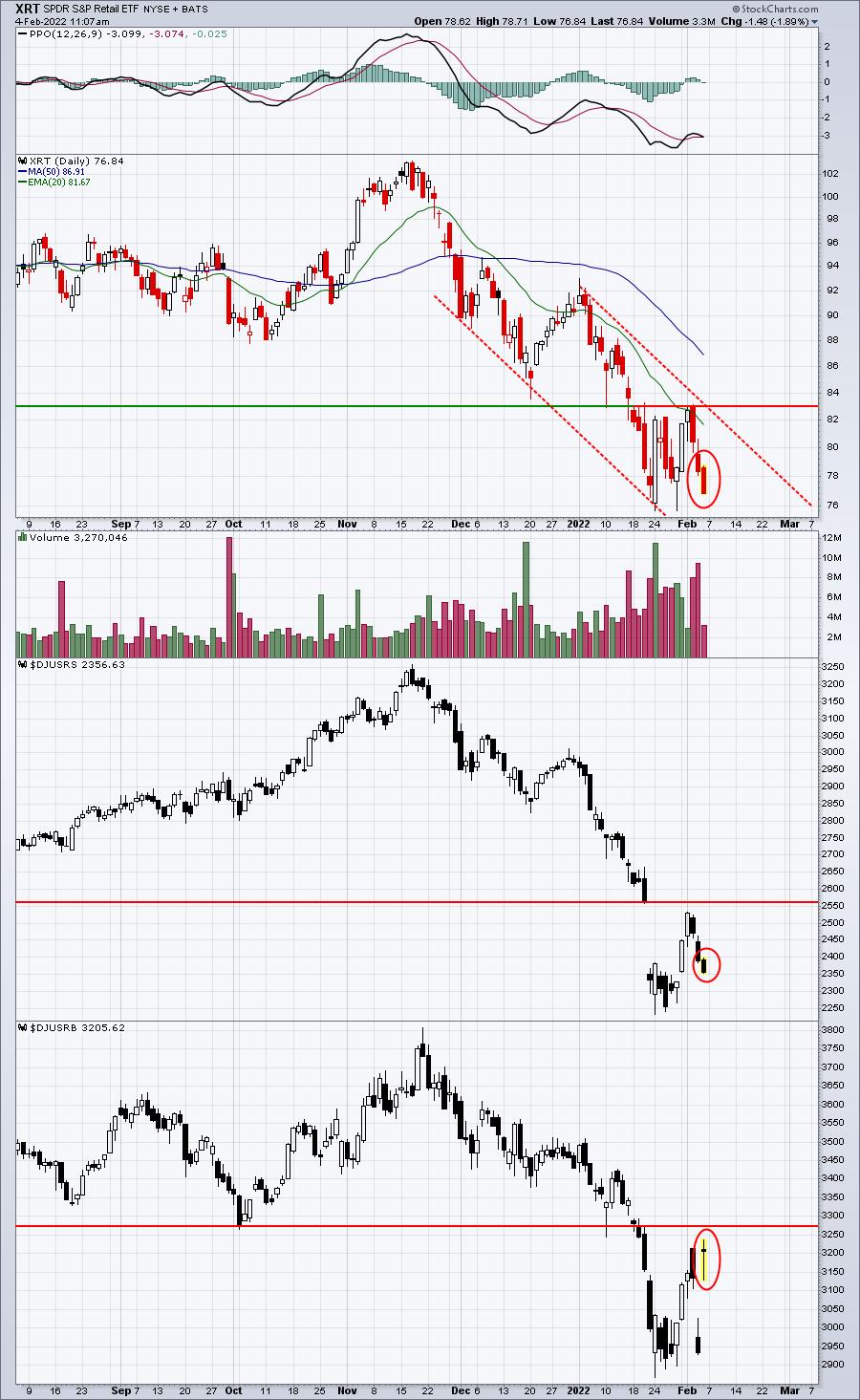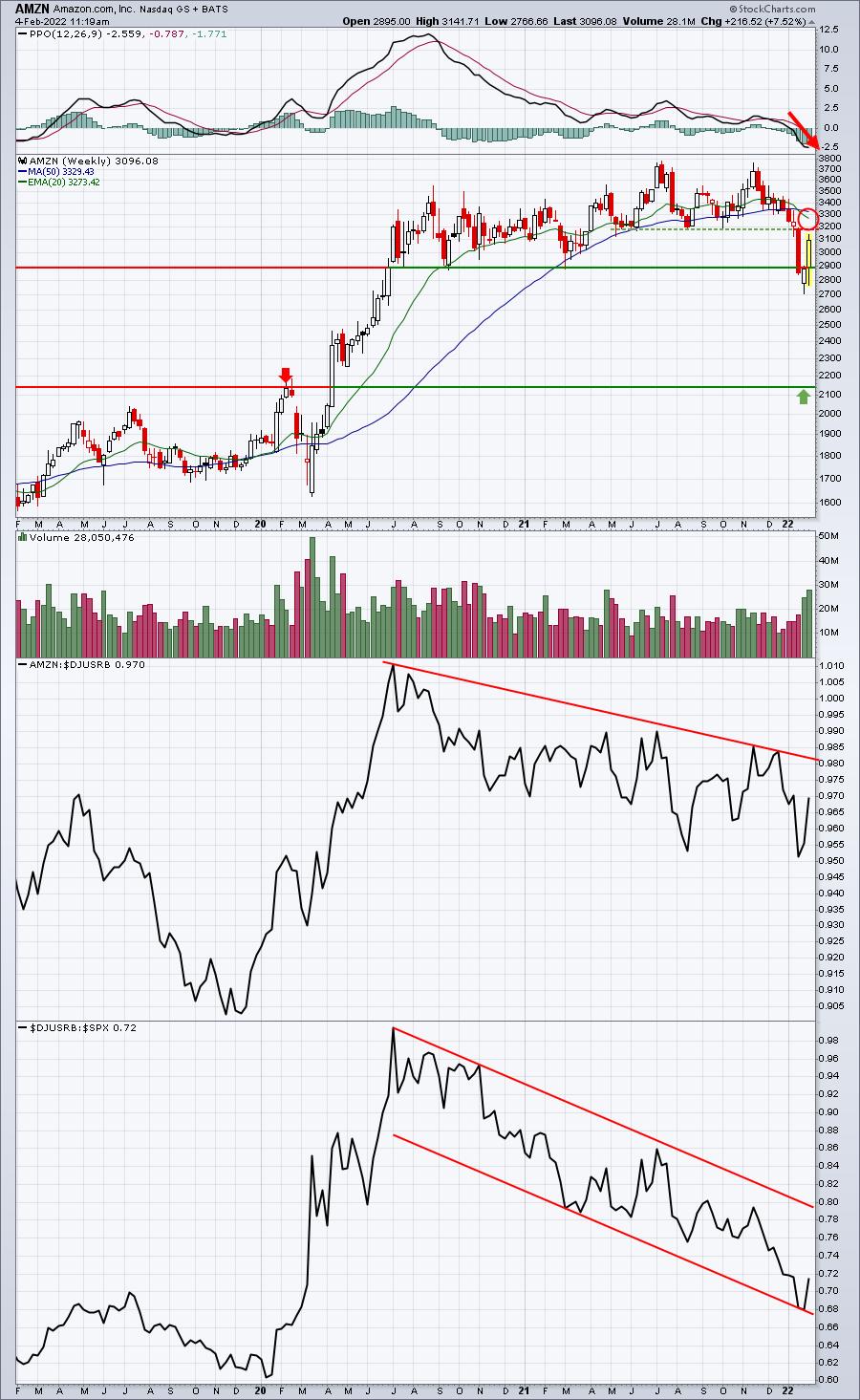Call it a reprieve. Amazon.com (AMZN) reported excellent results last night, at least much better than what was expected. Revenues came in a bit light, according to Zacks.com, at $137.41 billion. Estimates were pegged at $137.88 billion. But bottom line EPS soared to $27.75 (actual) vs. $3.89 (expected). Profits were largely aided by a pretax gain from its investment in Rivian (RIVN), which went public in November.
On the surface, the numbers looked pretty darn good, especially since there was so much attention centered on AMZN after the Meta Platforms (FB) debacle the day before. But when I look deeper, I'm honestly not that impressed. AMZN's cloud-computing segment provided nearly its entire profit. AMZN, to its credit, has evolved from a giant retailer into a plain ole GIANT. But its retail business speaks to more significant issues regarding the overall retail environment. Retailers have been crushed. Here's what AMZN's report did for the entire retail (XRT) sector today:

In the bottom panel, AMZN's big gap this morning has been parlayed into a big gap for the entire broadline retail group ($DJUSRB), which AMZN is a major part of.
But here are the two BIG problems for Amazon:
The Technical Outlook
As I read many bullish headlines about Amazon.com's (AMZN) results and bullish market reaction last night, I can't help but focus on the chart. AMZN just fell 235 bucks to close at 2777 yesterday. It had opened as recently as Wednesday morning at 3101. So while last night's reaction beats the heck out of the alternative, AMZN was trading slightly below 3100 just a few minutes ago. It remains in a violent downtrend and those buying the stock after today's gap higher is taking a significant risk, in my view. Hey, I love AMZN long-term. It's a wonderful company. This has nothing to do with what amazing products they have, their impeccable customer service, etc. I'm simply talking about whether the stock price is more likely to go higher or lower in the near- to intermediate-term. I'm just wondering out loud about the next 3-6 months. Check out this AMZN chart:

AMZN is a weak stock within broadline retail and broadline retail is badly lagging the S&P 500 - and has been for more than a year and a half. Let's not sugar coat what's going on here. Yes, AMZN is having a great day, but it appears to be within a very nasty long-term downtrend. I've circled in red the area of major price and moving average resistance I'd watch. So long as AMZN does not have a weekly close above 3200-3300, I'd consider it a downtrending stock and one to short on strength (like today).
The Market Environment
This isn't all AMZN's fault. The environment for all growth stocks has been bad and I believe it's only going to get worse in the first half of 2022. Are you watching the 10-year treasury yield ($TNX) today? It's up 11 basis points to 1.93%, the highest level since touching 1.95% on December 24, 2019, just prior to the pandemic in March 2020. Higher yields due to a rapidly-strengthening economy can be offset by future earnings growth. But in an inflationary environment with supply chain issues, few companies are going to be able to have the pricing power to maintain margins. And even flat margins will result in a massacre for a growth stock in this type of environment. Yes, AMZN should be successful in raising its Prime service $20 to $139/year. But if you think that will solve all of the issues that we face over the next several months, I wish you luck.
The January Effect
I've been warning constantly since mid-November (but especially since late-December) that major clouds were brewing and our January outlook was not looking good. Now, in the rear view mirror, we see the carnage and rubble. What's particularly deflating, however, is that the odds that U.S. equities just "snap back" like they've done over the past two years. I don't see it. And history tells us that it's not likely either. Tomorrow morning at 10:00am ET, I will be hosting a FREE (open to the public) "January Effect" webinar. I'll explain the fascinating connection between January performance and balance-of-the-year performance. It is VERY unlikely that the current secular bull market simply ignores the weakness in January. History tells us to respect this sudden weakness as it's quite likely that we're going lower.
For more information and to register for this FREE January Effect webinar, simply CLICK HERE and be sure to register in the area provided after the description of this event. I believe this webinar will help you navigate what lies ahead.
Happy trading!
Tom
